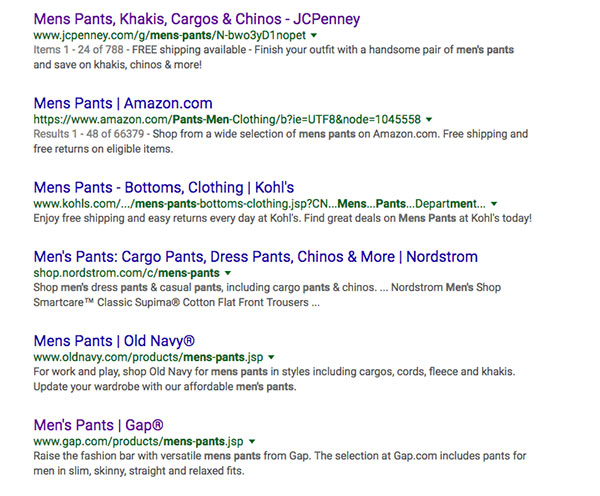Do URLs matter?
When was the last time you typed a specific URL into address bar of your browser?
For most users, searching the web is the only way to find content. The search bar has replaced the address bar. The word “Google” is actually a popular search term on Google.com. Even if you know a specific URL, most users aren’t typing it out–we rely on autofill. And if you find a specific page or site you want to revisit, you can always rely on good old-fashioned bookmarks to save them.
Knowing all this, the question then becomes, “do URLs even matter?"
Getting a good domain, like ElectricCitizen.com, still has value. It’s part of your brand for starters (same text as company name), indicating to the world that you are professional, consistent, and serious about business. And search engines do weigh the keywords of a domain into search results, meaning it’s a lot easier to find Electric Citizen (the agency) when we own the domain.
In one sample URL above, we had “kanye-west-visits-trump-tower” followed by a series of seemingly random numbers (406273016). A typical web user would likely ignore these extra digits, and focus on the keywords they wish to find. The numbers are likely means to ensure a unique and permanent URL for each article on the news site, but meaningless to the article content.
In the other URL from our site, the “about/danmoriarty” indicates both the content of the page (keywords), and the hierarchy in the site structure (this article is part of the overall “About” section of the website). The additional context given by the site structure increases user confidence in the relevance of the page URL, as well as adding additional keywords to the search results (“about”).
Using both site structure and keywords in a URL is the most effective way to get your content seen. So does everyone follow this pattern? Sometimes.
You might think browsing a clothing shop like the Gap for men’s pants would lead to a URL such as “gap.com/mens/pants”, but using site navigation leads to http://www.gap.com/browse/category.do?cid=80799#pageId=0&department=75. Why the longer URL here, with no keywords?
I’m sure they have reasons for the URLs in their site navigation, such as a very large, complex website, tracking inventory, user history and other things. But searching the web for men’s pants reveals that not only does the Gap also have the URL http://www.gap.com/products/mens-pants.jsp, but having those keywords in the URL positively affects search results. Many of the other major sellers of men’s pants are also seen in the search result, with URLs containing the appropriate keywords.

But what about site structure? The more friendly URLs have a structure of “products/mens-pants”, “shop/mens-pants”, or “shop/mens-clothing/pants”. How does this matter?

The way you organize site content matters. This includes your main site navigation as well as sections and subsections of content within your site. Who does it matter to? Search engines and site users.
When a user is reviewing a list of search results, they not only see the page titles and page summaries running down the page. They also are seeing the actual URLs of each page. These URLs are either reinforcing user confidence in your site, or turning you away.
If a user seeing the keywords they are searching for within the URL, it increases user trust. If a user sees 2 different links for men’s pants, and one is “shop/mens-pants” and the other is “browse/category.do?cid=80799#pageId=0&department=75”, the easier to read version wins every time.

In addition to the visual appearance in search results, having navigation paths in a URL can be a search boost. Using categories in your URL structure gives users context on what the page may be about, and allows you to use keywords without being spammy in the URL. In the example above, you can see that having the path of "mens-clothing" in the URL does affect search results, and would increase confidence in the end user choosing this link.
These aren't the only reasons, of course. The most obvious advantage of having content organized in logical and consistent navigation categories? Better user experience.
By making the hierarchy visible, navigation tells us what the site contains. Navigation reveals content! And revealing the site may be even more important than guiding or situating us.

While matching URLs to site navigation is a practice we recommend, there are a few caveats to note.
Going back to our pants example – while finding pants under “shop/mens/pants” has value to users and search engine rankings, going further into a deep site navigation can lead to longer, more unwieldy URLs such as “shop/mens/pants/corduroy/husky/sale/red”. Are these longer URLs bad? Maybe.
URLs in a CMS are typically automated to match a site structure, so there’s usually not any extra work involved for site editors. And the keywords and structure are still there, so there’s benefit in search results. Plus, site visitors aren’t bothering to actually type these URLs out in an address bar, or paying too close attention to the URL at all, so length doesn’t matter to them (in this sense). But there’s a few things to keep in mind.
- URL length – Google will only show so many characters of a URL in the search results, meaning some of those rich keywords will be missing from view
- User confidence – while many users aren’t paying close attention to the actual URLs, those who do may be dissuaded by long, confusing paths.
- Penalty for deep content – the “deeper” content appears to be on a site, the less relevant it may ranked by a search engine. For example, a page simply about “red-corduroy-pants” is considered more relevant at a “top-level URL” versus a page that is 6+ navigation levels deep on a site.
Having keywords and site structure in a URL is valuable, as long as you don’t go too deep. How do maintain both? Consider a site structure/navigation that is ‘flat and wide’ versus ‘narrow and deep.’ Three levels deep per category is a good rule of thumb. On expansive, content-rich sites, it may not be possible to limit results to 3 levels deep without expanding the main navigation too greatly. The “top-level” navigation should be keep at 6-8 choices maximum, if you can. An article at Nielsen Norman talks about strategies to handling content-rich sites, and the flat vs deep debate.
URLs do matter. Not because anyone is typing them in the browser, but because of search engines, how content gets indexed, and how users browse search results.
If you have relevant page content and a relevant page title, you’re halfway there. Have a URL that includes the page title and site structure, but nothing too deep and long. Users will then find your content easier, and feel more confident choosing the links they find.


Join the Discussion +